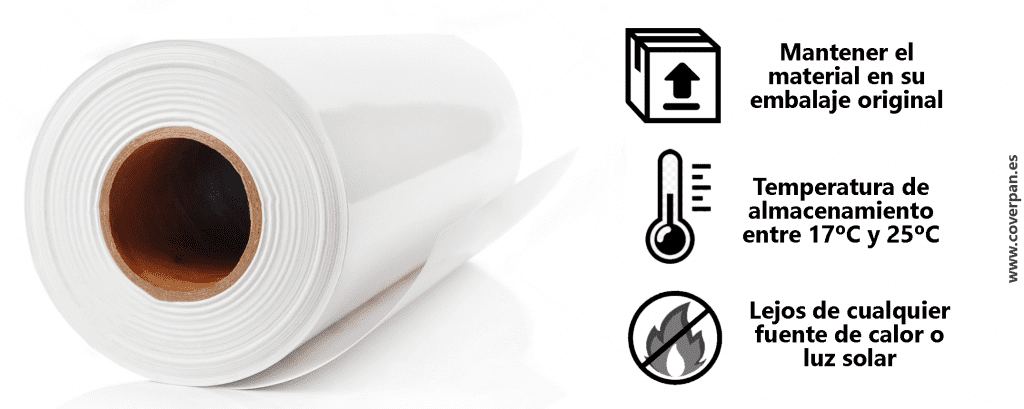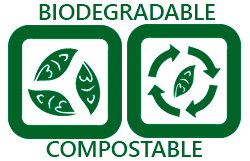What is compostability?
Composting is a type of biodegradation that in determinated conditions of oxygen and temperature, the packaging or product is degraded by the action of bacteria or microorganisms.
This means that the waste generated is a resource that is returned to the soil again in the form of compost or quality fertilizer that is reincorporated into the cycle of the Circular Economy.
How long does it take for compostable packaging to decompose?
Conventional plastic waste takes between 35 and 300 years to decompose, although waste such as plastic bottles can take around 700 years to degrade.
Biodegradable packaging micro-fragments in approximately 6 months, although this depends on factors such as climate and environment.
The time it takes for a compostable container to decompose depends on several factors, such as the type of material it is made of, the environmental conditions in which it is found and the composting system used.
Compostable packaging is designed to decompose in an industrial or home composting environment, where the right conditions are created for microorganisms to break it down into organic matter.
For example, some compostable packaging can take 2 to 6 months to decompose in an industrial composting environment. However, in a domestic environment, where composting conditions may be less controlled, the decomposition process could take longer.
It is important to note that although compostable packaging is designed to decompose more quickly than conventional packaging, it is important to ensure that it is properly disposed of in the organic garbage can so that it is properly processed.
Under what conditions does compostable packaging decompose?
Under normal conditions, biodegradable and compostable packaging is inert and does not degrade spontaneously. To initiate a composting process would require a combination of the following conditions:
After the selective collection of organic waste, the waste is taken to an industrial composting plant where an accelerated anaerobic fermentation process takes place.
In cold or rainy places, the anaerobic digestion process is widespread.
The abovementioned process variables: moisture content, carbon-nitrogen ratio, temperature, pH, retention time, etc., are controlled, managed and optimized in order to achieve a faster and more complete degradation, with a minimum impact on the environment.
During the process, the oxygen supply necessary for the bacterial flora is controlled to ensure the correct aerobic fermentation of the organic matter. Water and high temperatures are also added to dry the organic matter. As the humidity level decreases, the bacterial flora suffers and the effectiveness and speed of the process decreases.
Darkness favors the proliferation of bacteria and microorganisms, and thanks to the previous supply of moisture and oxygen, accelerates the decomposition process of organic matter.
Microorganisms, such as bacteria, and large invertebrates such as earthworms and insects, help decompose crop residues by ingesting and mixing them with the parent mineral in the soil; in the process they recycle energy and nutrients from the plants.
To summarize, a compostable container or material begins to decompose once the above conditions are met. The fact of being biodegradable and compostable does not mean that it degrades just because, but in a composting plant or with the garbage in the presence of microorganisms, etc. etc. etc.
How to compost PackInGreen packaging?
When you have finished using a PackInGreen container, which is made from organic materials such as corn starch or potatoes, you can put it in the brown garbage can for organic waste or in your home composter.
Brown garbage can (industrial compost)
If we dispose of our compostable packaging in the brown container of organic waste, it will be transported to an industrial composting plant, and thanks to the intervention of oxygen, nitrogen, carbon and microorganisms, it will result in an organic fertilizer that can be used as agricultural or gardening fertilizer.
Home composter (Home compost)
If, on the other hand, you have a home composter at home and you want to compost your packaging there, here are some recommendations to take into account in order to carry out this procedure correctly.
1) Wash the containers to avoid leaving residues like oils or other materials that are not beneficial for your compost.
2) Cut the container into pieces of up to 5 centimeters to accelerate the biodegradation process. The time required for your container to become compost will be approximately 24 weeks, the period it takes for organic matter to decompose.
3) Incorporate in your compost materials balanced in carbon and nitrogen, such as leaves from fruit trees and shrubs, or fine branches.
4) Provide the necessary moisture. Although the microorganisms that will decompose our containers need moisture to survive, excess water will cause the material to rot, generating unpleasant smells. To check if there is enough moisture, you can take a handful of compost and squeeze it with your hand: If your hand gets wet but no water drips through your fingers, the moisture is optimal.
5) Keep your compost bin at temperatures between 35 and 65 ºC. At these temperatures, degradation of organic matter occurs. In addition, most pathogenic organisms and parasites do not survive at these temperatures.
Storage conditions
We tend to think that packaging may start to decompose in our warehouse or at some point in the supply chain but the reality is that biodegradable and/or compostable materials never degrade spontaneously.
To preserve their properties, storage in low humidity environments and at temperatures between 17ºC and 25ºC is recommended.

Our compostable packaging
At Coverpan we are pioneers in the manufacture of paper-based flexible packaging with biodegradable and compostable films, all of them customizable with certified inks and adhesives.
If you want to know more about our PackInGreen packaging, please contact us.




